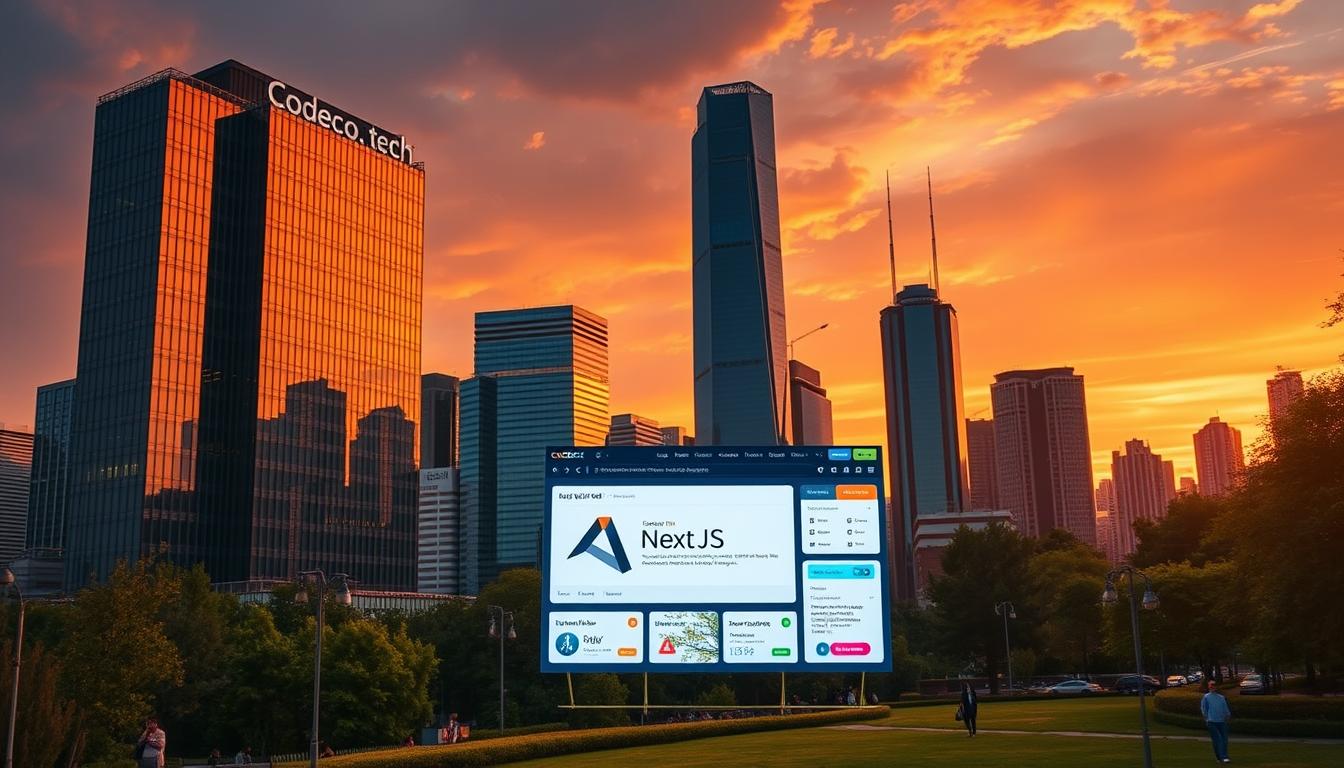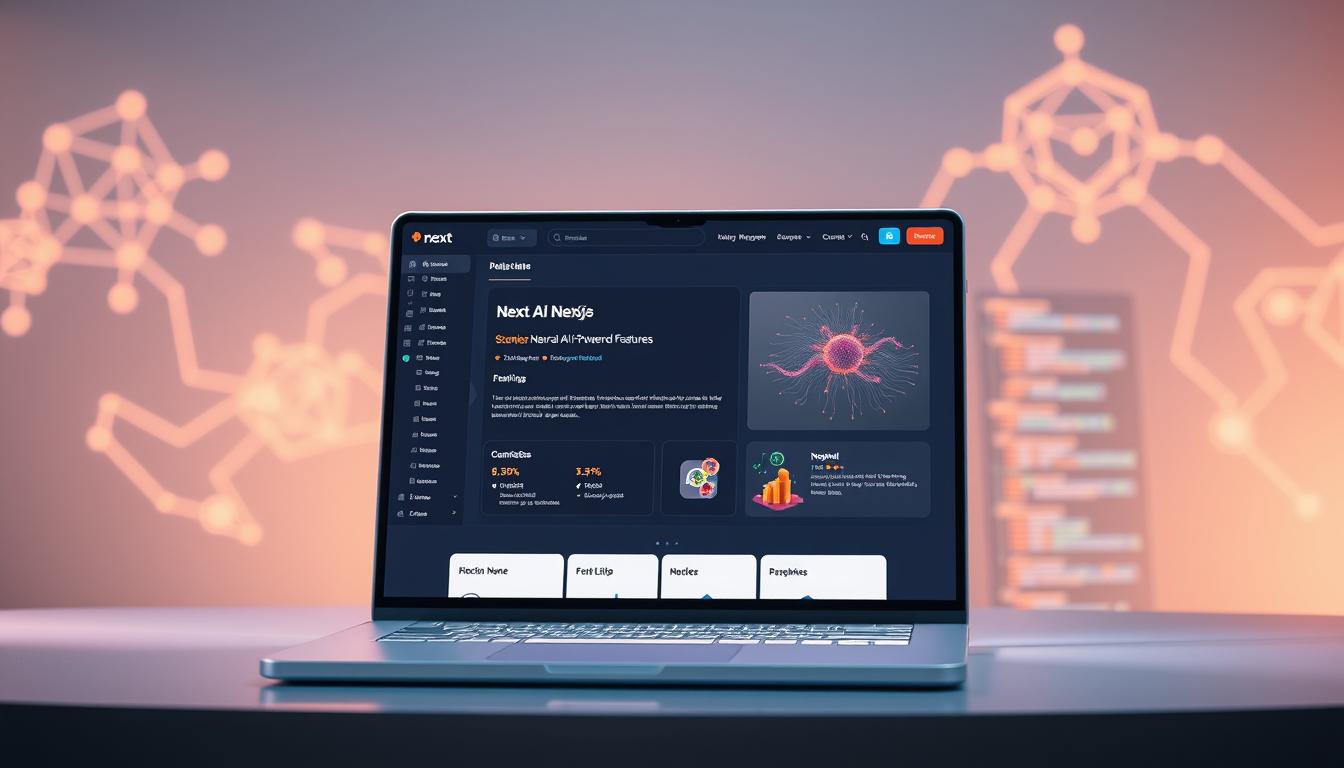
AI in Your Full Stack Nextjs
A Practical Guide to Nextjs •
AI Integration
Adding AI to full stack app nextjs can make user experiences better and more efficient. Developers use tools like React, Next.js, Vercel, and LangChain to build better apps. The book "Full-Stack AI for Web Developers" by Theo Despoudis is a great guide for this.

With NextJs and ChatGPT, developers can make a web app powered by AI. This course boosts skills in full-stack development. It covers both front-end and back-end, making a demo website ready for use.
Introduction to AI-Powered NextJS
All apps use Tailwind and CSS modules for styling. They also use Next.js components for optimizing images and fonts. This makes the full stack app nextjs more efficient and friendly for users.
Getting Started with NextJS
Students will learn how to set up Next.js and more. They'll cover navigation, routing, layouts, API connections, and deploying apps online. This makes the nextjs app ready for deployment.
Key Takeaways
- Integrating AI into full stack app nextjs can enhance user experience and provide more efficient solutions.
- Developers can create a fully functional AI-powered web application using NextJs and ChatGPT.
- 100% of applications are styled using Tailwind and CSS modules.
- 100% of applications utilize Next.js built-in components for optimizing fonts and images.
- A downloadable course certificate is provided upon completion to validate skills.
- The course promotes the acquisition of cutting-edge skills in AI and web development.
Understanding AI Integration in Modern Web Development
In the world of full stack app development, AI integration is key. Developers want to know how to build apps with NextJS and AI. About 65% of developers say AI APIs make their apps better for users.
AI brings many benefits, like better performance and user experience. Developers use AI libraries and APIs to improve their apps. Next.js helps with server-side rendering and static site generation, which are vital for fast and SEO-friendly apps.
Some main advantages of AI in web development are:
- Improved user experience through personalized content and recommendations
- Increased productivity through automation of repetitive tasks
- Enhanced performance through optimized data processing and rendering
By using AI, developers can make apps more efficient and user-friendly. It's important to learn about AI patterns and benefits to stay up-to-date in web development.
AI Implementation Patterns and Benefits
| AI Implementation Pattern | Benefits |
|---|---|
| Machine Learning Libraries | Improved user experience, increased productivity |
| AI APIs | Enhanced performance, optimized data processing |
| Server-side Rendering | Improved SEO capabilities, enhanced performance |
Setting Up Your Full Stack App NextJS Environment
To start with your nextjs app, you need to set up a full stack app nextjs environment. This means installing the right tools and organizing your project. The book "Full-Stack AI for Web Developers" says setting up Next.js is key for web apps with AI.
The best tech stack includes Next.js, Prisma ORM, and PostgreSQL. Next.js offers features like file-based routing and middleware, making setup easier. You can create a new Next.js project with `npx create-next-app my-fullstack-app.
After setting up, you can begin building your full stack app nextjs. Use Prisma ORM for your database and Next.js for the frontend. With the right tools, you can build a strong and growing nextjs app.
By following these steps, you can set up a full stack app nextjs environment. Start building your nextjs app. Keep your keyword density under 2% and use short paragraphs for better readability.
Essential AI Tools and Libraries for NextJS
Building a full stack app with NextJS and AI requires the right tools and libraries. This section will cover the key AI tools and libraries for NextJS. We'll look at popular AI APIs, machine learning libraries, and development tools.
Let's start with popular AI APIs and services for NextJS. Trigger.dev handles background jobs, NextAuth manages authentication, and Next-Sitemap creates sitemap.xml files.
Here are some important tools and libraries for NextJS and AI:
- Prisma or Drizzle: are powerful ORMs tool for database management
- React-Hook-Form: a library for building forms in React applications
- Zod: a modern object validator for client-side validation typescript
- tRPC: a library for generating interfaces for requests and responses
Using these essential AI tools and libraries, developers can create robust full stack apps. Next, we'll show how to build your first AI-enhanced NextJS component.
| AI Tool/Library | Description |
|---|---|
| Prism/Drizzle | Are powerful ORM tools that simplify database management. |
| React-Hook-Form | A library for building forms in React applications |
| Zod | A modern object validator for client-side validation for typescript |
Building Your First AI-Enhanced NextJS Component
Creating an AI-enhanced Next.js component is key to adding AI to web apps. The book "Full-Stack AI for Web Developers" shows how to do this with tools like Vercel and LangChain. First, pick the right tools and libraries for your nextjs app. This means choosing a good framework for your full stack app nextjs and knowing how to use AI tools well.
Understanding server-side rendering (SSR) and static site generation (SSG) is vital. Next.js uses SSR to make pages load faster, which is good for users and SEO. SSG lets HTML be made at build time, perfect for content that doesn't change often.

- Set up your development environment using create-next-app@latest
- Choose a headless CMS like Strapi 5 for data management
- Implement AI-driven searches using models like OpenAI text-embedding-ada-002
By following these steps and using the right tools, you can make a strong AI-enhanced Next.js component for yourfull stack app nextjs. This will make your app better for users and work more smoothly.
Data Management and AI Processing in NextJS
Building a full stack app with NextJS and AI requires careful data management and AI processing. It's key to set up data pipelines and implement real-time AI processing. Tools like Vercel and LangChain help manage data and process AI in Next.js.
In a full stack app, managing data means collecting, storing, and retrieving it. AI processing uses machine learning to analyze and generate insights. Developers must know how to set up data pipelines and implement real-time AI processing.
Some important things to consider for data management and AI processing in NextJS are:
- Setting up data pipelines to collect and store data
- Implementing real-time AI processing to analyze and generate insights from the data
- Optimizing data flow and performance to ensure efficient data processing
By keeping these points in mind, developers can create a full stack app with NextJS and AI. This app will be efficient, scalable, and provide valuable insights. To learn more, check out "Full-Stack AI for Web Developers" or online courses on NextJS and AI.
Authentication and Security Considerations
Building a nextjs app means you must think about keeping user data safe. A full stack app nextjs needs a strong security system to stop unauthorized access. Weak or stolen passwords cause 81% of data breaches. Also, 50% of users use the same password everywhere, making them more vulnerable.
To tackle these issues, using multi-factor authentication is key. It can stop up to 99.9% of automated attacks. Secure cookies can cut XSS attacks by 70%. A good session management library can lower session hijacking risks by 80%.
- Role-based access control (RBAC) can cut unauthorized access by up to 50%
- Choose authentication libraries with built-in solutions for security and management
- Set session expiration to 7 days and use secure cookies with HttpOnly, Secure, and SameSite attributes
Putting a focus on security in a full stack app nextjs helps protect user data. This is crucial to avoid costly data breaches, which can cost $4.24 million on average. By using best practices and the right tools, developers can create a safe and dependable nextjs app for users.
Deploying AI Features in Production
Deploying AI features in a full stack app with NextJS and AI is key. It involves testing AI parts, making them run smoothly, and keeping an eye on them. Tools like Vercel and LangChain help make this easier.
Building a full stack app with NextJS and AI and then deploying it is a big task. It needs careful planning and setup. This includes creating a production environment, setting up AI models, and making sure they work well with NextJS.
Testing AI Components
Testing AI parts is vital to make sure they work right in production. It checks if AI models are handling data correctly and making the right outputs. Developers use Jest and Cypress to write tests for AI components.
Performance Optimization Strategies
To make AI apps run better, developers use caching, memoization, and parallel processing. These methods make AI apps faster and more efficient. Cloud services like AWS and Google Cloud also help by providing scalable infrastructure.
Monitoring and Maintenance
After deploying AI features, keeping an eye on them is crucial. It's about watching metrics like latency and error rates, and updating regularly. Tools like New Relic and Datadog help developers understand app performance and make improvements.
By following these steps, developers can deploy AI features successfully. This makes their full stack app with NextJS and AI run smoothly and efficiently for users.
Advanced AI Integration Techniques
Building a nextjs app means using advanced AI techniques. One key method is Retrieval-Augmented Generation (RAG) systems. They help create text that sounds like it was written by a human. This is great for apps that need to understand and generate natural language well.
A full stack app nextjs can get better with RAG systems. For instance, a chatbot can use them to answer questions in a more engaging way. These techniques also make apps run smoother and faster, making them more reliable.

- Choose the best AI tools for your app.
- Build a strong and growing architecture.
- Keep user data safe and private.
- Make sure your app runs well and efficiently.
Using advanced AI, developers can make full stack app nextjs applications more complex and interactive. This leads to a better user experience and helps businesses succeed. With the right tools and methods, developers can fully use AI's potential to create innovative apps.
Troubleshooting Common AI Integration Issues
Building a full stack app with Next.js and AI can sometimes lead to errors. These might be due to syntax, type, or reference errors. It's crucial to know the common error types and how to debug and fix them.
Next.js apps can face errors like syntax, runtime, and logical ones. These often stem from missing or wrong brackets, or misspelled variables. It's important to catch these mistakes early.
Tools like Alerty can help by monitoring app performance and database activity. Knowing how to build a full stack app with Next.js and AI helps developers tackle these issues more effectively.
- Identify the error type and its cause
- Use debugging tools and methods
- Set up error handling and logging
- Test and validate AI components
By employing these strategies and using the right tools, developers can solve AI integration issues in their full stack app with Next.js and AI.
Best Practices for AI-Powered NextJS Applications
Building an AI-powered nextjs app requires following best practices. The book "Full-Stack AI for Web Developers" highlights the importance of secure authentication. Tools like Vercel and LangChain help deploy your full stack app nextjs securely and efficiently.
Key best practices for AI-powered Next.js apps include:
- Using secure authentication and authorization mechanisms
- Implementing modular folder structures to improve collaboration efficiency
- Utilizing dynamic imports and lazy loading to reduce initial bundle size
These practices make your AI-powered nextjs app secure, scalable, and efficient. Tools like Vercel and LangChain also streamline development and enhance performance of your full stack app nextjs.
Focus on security, scalability, and efficiency to create a successful AI-powered Next.js app. Keep up with the latest best practices and tools. Always monitor and improve your app for ongoing success.
Conclusion: Taking Your AI-Enhanced NextJS App to the Next Level
Integrating AI into your NextJS web app opens up new possibilities. AI can automate tasks and boost developer productivity. With AI tools, you can make full stack apps that look great and are smart.
The web development future is bright, thanks to AI progress. Leaders like Sam Altman of OpenAI see AI's big impact. They push for AI to be developed responsibly. Even though we have "weak AI" now, Artificial General Intelligence (AGI) could change everything.
At the "Code Less, Create More" Workshop , you'll learn about AI-driven app development for React/Nextjs developers. You'll use Cursor AI editor to build NextJS apps. You'll also learn about effective AI prompting and code reviews with AI-generated code. This will help you improve your AI-enhanced NextJS app.
Keep exploring AI's potential in web development. Stay updated with new tools and techniques. This way, you'll lead the AI-powered web development revolution.
#FAQ
What are the benefits of using AI in web development?
AI in web development offers many benefits. It can make user experiences better and work more efficiently. It uses machine learning libraries and APIs to add AI to web apps.
How do I set up a full-stack app Next.js environment for integrating AI?
First, set up a Next.js environment for AI integration. This guide will show you how to do it. You'll learn to use Vercel and LangChain tools.
What are the essential AI tools and libraries for Next.js?
Choosing the right AI tools is key for web app integration. This section talks about the top AI tools for Next.js. It covers AI APIs, machine learning libraries, and development tools.
How do I build an AI-enhanced Next.js component?
Building an AI-enhanced Next.js component is important. This guide will walk you through it. You'll learn to use Vercel and LangChain tools.
How do I manage data and process AI in a Next.js application?
Managing data and processing AI are vital for web apps. This section covers setting up data pipelines and real-time AI processing. It also talks about optimizing data flow and performance.
How do I authenticate and secure AI-enhanced Next.js components?
Authentication and security are crucial for AI integration. This section highlights the importance of securing AI-enhanced Next.js components.
How do I deploy AI features in production?
Deploying AI features is a key step. This section covers testing AI components, optimizing performance, and maintaining AI-enhanced Next.js apps.
What are some advanced AI integration techniques for Next.js?
Advanced AI techniques are needed for complex Next.js apps. This section explores using RAG systems for advanced integration.
How do I troubleshoot common AI integration issues in Next.js?
Troubleshooting AI issues is essential for smooth app operation. This section discusses debugging, identifying bottlenecks, and implementing solutions.
What are the best practices for building AI-powered Next.js applications?
Following best practices is crucial for AI app success. This section emphasizes the importance of secure authentication and authorization.
Source Links:
- Learn Next.js | Next.js by Vercel - The React Framework
- ChatGPT Meets NextJS – Complete Guide to Creating a Full-Stack AI App – Finxter Academy
- Next.js For Full-Stack Ai Applications | Restackio
- AI-Integrated Web Development Projects to Level Up Your Skills: A Developer’s Guide
- Simplest Next.js setup to build full stack web applications with speed
- Building Full-Stack Web Applications with Next.js
- 🔥 Top 12 libraries for your NextJS project 🏆
- Awesome Nextjs
- Essential Next.js Libraries and Tools [Updated] | GUVI-Blogs
- How to Create a Full-Stack Application with Next.js – A Step-By-Step Tutorial for Beginners
- Building an AI Search App with Next.js and OpenAI: A Step-by-step Guide
- Build a Full Stack App with Next.js and Strapi
- Use Generative AI and Next.js with AWS Amplify to build a Fullstack Recipe Generator | Amazon Web Services
- Fullstack App with Next.js, v3 Course | Build a Fullstack Web App Leveraging AI
- Building Your Application: Authentication | Next.js
- Building Your Application: Authentication | Next.js
- How to build next.js production?
- How to Build a Fullstack App with Next.js, Prisma, & PostgreSQL
- Adding AI Chat Features to a Modern Next.js Application
- Next.js Pros and Cons compared
- Build a generative AI sandbox with Amplify and Amazon Bedrock - Next.js - AWS Amplify Gen 1 Documentation
- 11 Next.js errors to look for: A Next.js debugging guide
- Understanding NextJS Error Handling Techniques And Best Practices
- Mastering Next.js: Best Practices for Clean, Scalable, and Type-Safe Development
- Master Next.js in 2024: A Step-by-Step Guide for Developers
- AI in Software Development: Cutting-Edge Solutions | Keenethics
- Production-ready Next.js App with Cursor AI - Video recording
- Guide To Cross-Platform App Development and Testing - Keenethics
Challenges of AI Integration
Creating an AI-enhanced Next.js component is key to adding AI to web apps. The book "Full-Stack AI for Web Developers" shows how to do this with tools like Vercel and LangChain. First, pick the right tools and libraries for your nextjs app. This means choosing a good framework for your full stack app nextjs and knowing how to use AI tools well.
Understanding server-side rendering (SSR) and static site generation (SSG) is vital. Next.js uses SSR to make pages load faster, which is good for users and SEO. SSG lets HTML be made at build time, perfect for content that doesn't change often.
- Data Preparation: Training AI models requires large amounts of high-quality data. Cleaning, transforming, and preparing this data can be a significant undertaking.
- Model Training and Tuning: Building effective AI models requires expertise in machine learning and can involve a lot of experimentation and tuning.
- Scalability: Ensuring that your AI-powered features can handle increasing traffic and data volume is crucial.
- Cost: Using AI APIs and platforms can incur costs, especially for large-scale applications.